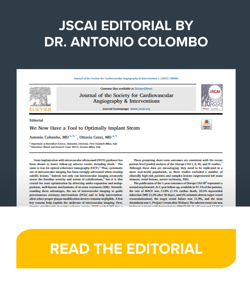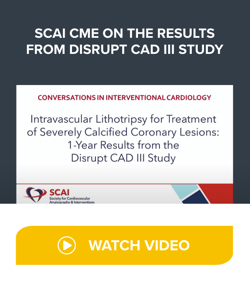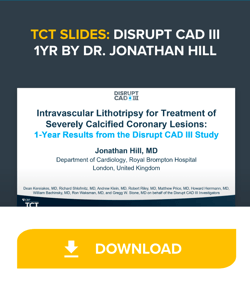Disrupt CAD III 1yr Data Published in First Edition of JSCAI
The one-year Disrupt CAD III data has been published in JSCAI – the new journal of the Society for Cardiovascular Angiography & Interventions. The new data from Disrupt CAD III confirm the consistency of the excellent safety and effectiveness outcomes at 30 days out to one year.
“It is very significant that these data show sustained and persistent relative benefit of IVL for lesion preparation prior to coronary stenting, particularly since this is the first robust one-year report that has been presented on the technology,'' said Dean Kereiakes, M.D., FACC, FSCAI, Medical Director of The Christ Hospital Heart and Vascular Center and the Christ Hospital Research Institute; Professor of Clinical Medicine, The Ohio State University; Co-Principal Investigator of Disrupt CAD III.
Read the JSCAI Publication here:
https://www.jscai.org/article/S2772-9303(21)00001-6/fulltext
For more information, please see the editorial by Dr. Antonio Colombo, which was also featured in the first edition of JSCAI, the SCAI CME on the results from the Disrupt CAD III Study, and the slides presented by Dr. Jonathan Hill at TCT21 below.
About JSCAI: JSCAI is an online only, peer-reviewed, international, Gold Open Access journal covering the broad field of cardiovascular diseases. JSCAI aims to be a highly credible and well-balanced reference highlighting practical techniques and pathways of care to deliver high impact scientific contributions from clinicians and colleagues in interventional cardiology.
More on Disrupt CAD III 1-Year Data
Important Safety Information
In the United States: Rx only
Indications for Use—The Shockwave Intravascular Lithotripsy (IVL) System with the Shockwave C2 Coronary IVL Catheter is indicated for lithotripsy enabled, low-pressure balloon dilatation of severely calcified, stenotic de novo coronary arteries prior to stenting.
Contraindications—The Shockwave C2 Coronary IVL System is contraindicated for the following: This device is not intended for stent delivery. This device is not intended for use in carotid or cerebrovascular arteries.
Warnings— Use the IVL Generator in accordance with recommended settings as stated in the Operator’s Manual. The risk of a dissection or
perforation is increased in severely calcified lesions undergoing percutaneous treatment, including IVL. Appropriate provisional interventions should be readily available. Balloon loss of pressure was associated with a numerical increase in dissection which was not statistically significant and was not associated with MACE. Analysis indicates calcium length is a predictor of dissection and balloon loss of pressure. IVL generates mechanical pulses which may cause atrial or ventricular capture in bradycardic patients. In patients with implantable pacemakers and defibrillators, the asynchronous capture may interact with the sensing capabilities. Monitoring of the electrocardiographic rhythm and continuous arterial pressure during IVL treatment is required. In the event of clinically significant hemodynamic effects, temporarily cease delivery of IVL therapy.
Precautions— Only to be used by physicians trained in angiography and intravascular coronary procedures. Use only the recommended balloon
inflation medium. Hydrophilic coating to be wet only with normal saline or water and care must be taken with sharp objects to avoid damage to the hydrophilic coating. Appropriate anticoagulant therapy should be administered by the physician. Precaution should be taken when treating patients with previous stenting within 5mm of target lesion.
Potential adverse effects consistent with standard based cardiac interventions include– Abrupt vessel closure – Allergic reaction to contrast medium, anticoagulant and/or antithrombotic therapy-Aneurysm-Arrhythmia-Arteriovenous fistula-Bleeding complications-Cardiac tamponade or pericardial effusion-Cardiopulmonary arrest-Cerebrovascular accident (CVA)-Coronary artery/vessel occlusion, perforation, rupture or dissection-Coronary artery spasm-Death-Emboli (air, tissue, thrombus or atherosclerotic emboli)-Emergency or non-emergency coronary artery bypass surgery-Emergency or non-emergency percutaneous coronary intervention-Entry site complications-Fracture of the guide wire or failure/malfunction of any component of the device that may or may not lead to device embolism, dissection, serious injury or surgical intervention-Hematoma at the vascular access site(s)-Hemorrhage-Hypertension/Hypotension-Infection/sepsis/fever-Myocardial Infarction-Myocardial Ischemia or unstable angina-Pain-Peripheral Ischemia-Pseudoaneurysm-Renal failure/insufficiency-Restenosis of the treated coronary artery leading to revascularization-Shock/pulmonary edema-Slow flow, no reflow, or abrupt closure of coronary artery-Stroke-Thrombus-Vessel closure, abrupt-Vessel injury requiring surgical repair-Vessel dissection, perforation, rupture, or spasm.
Risks identified as related to the device and its use: Allergic/immunologic reaction to the catheter material(s) or coating-Device malfunction, failure, or balloon loss of pressure leading to device embolism, dissection, serious injury or surgical intervention-Atrial or ventricular extrasystole-Atrial or ventricular capture.
Prior to use, please reference the Instructions for Use for more information on warnings, precautions and adverse events.
https://shockwavemedical.com/IFU
Please contact your local Shockwave representative for specific country availability and refer to the Shockwave C2 Instructions for Use containing important safety information.






